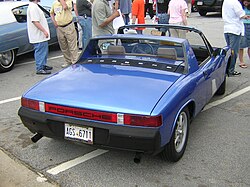Targa top

Targa top, targa for short, is a semi-convertible car body style with a removable roof section and a full width roll bar behind the seats. The term was first used on the 1966 Porsche 911 Targa,[1] and it remains a registered trademark of Porsche AG.[2]
The rear window is normally fixed, but on some targa models, it is removable or foldable, making it a convertible-type vehicle. Any piece of metal or trim which rises up from the side of a car and continues in an uninterrupted line over the roof and down the other side is sometimes called a targa band, targa bar or a wrapover band.
Targa tops are different from T-tops, which have a solid, non-removable bar running between the top of the windscreen and the rear roll-bar, and generally have two separate roof panels above the seats that fit between the window and central t-bar.
Origination

The word targa first came into use from the 1966 Porsche 911 Targa, though the first production car with this system as an option was actually released five years before: namely the 1961 Triumph TR4, where it was commonly called a surrey top. It was also used on the 1964 SAAB Catherina prototype.
The targa syle roof opening became popular in the 1960s and 1970s, when there were fears that the Department of Transportation (DOT) in the United States would ban convertibles, due to concerns over the safety of occupants when a car overturns. As a result, manufacturers adopted Targa tops or T bars. As Porsche helped to popularise this body style, they took out a trademark for the Targa name and manufacturers sought for alternative names for their removable tops. Porsche got the name "Targa" from the Targa Florio, the famous road race in Sicily where Porsche was very successful. Targa means "plate" in Italian.
Targa and T-top numbers have slowly declined as manufacturers discontinued them in favour of full convertibles with retractable hardtops and folding metal roofs such as the Mercedes-Benz SLK, and by better structural engineering with pop-up roll over bars behind the seats and front roll-over bar incorporated into the front windscreen,
Glass roof
1996 saw the debut of a retractable glass roof in the Porsche 993 Targa, a design continued on the 996 Targa. The glass roof retracted underneath the rear window revealing a large opening. A shade was there to help prevent the greenhouse effect of the closed roof. This system was a complete redesign, as previous Targa models had a removable roof section and a wide B-pillar functioning as a roll bar. The new glass roof design allowed the 993 Targa to retain nearly the same side-on profile as the other 911 Carrera variants and eliminated the inconvenience of storing the removed top of the old system. The Targa had the body of the Cabriolet with the Targa glass roof replacing the fabric roof. The 911 Targa continued with the all-new 996-model and gained a lifting hatchback glass window.[3] This, in turn, was used on the later 997 model of 911.
Rotating roof
Ferrari introduced a hybrid variation of the targa roof and folding metal roof with the 180 degree rotating roof featured on the 2005 Ferrari 575M Maranello Superamerica. The concept was also used in the 2010 Renault Wind.
Examples of traditional Targa-Top
Examples of the Targa car and T-bar top body style include:
- AMC Eagle Sundancer (1980–84)
- Bentley Continental SC
- Bugatti Veyron Grand Sport (2009-current)
- Chevrolet Camaro (1978–2002)
- Chevrolet Corvette coupe (1968–current) 2001–2004 and 2006+ Z06 excluded
- Dodge Viper (1992–2002)
- Ferrari 250P / 250LM / 330P / 330P2 / 330P3 / 330P4 / 412P / 312P
- Ferrari 308 GTS
- Ferrari 328 GTS
- Ferrari 348 TS
- Ferrari 512S/512M
- Ferrari Dino 246 GTS
- Ferrari F355 GTS
- Fiat X1/9
- Ford GTX-1 (1966 12 Hours of Sebring winner)
- Ford GTX-1 Roadster (2005)
- Honda CR-X del Sol
- Honda NSX-T
- Jaguar XJ-SC 'twin-targa' cabriolet (1984–1988)[4]
- All Koenigsegg models (2004–present)
- Lamborghini Diablo VT Roadster
- Lamborghini Miura Roadster
- Lotus Elise
- Maserati MC12
- Matra 530
- Mazda RX-7 (SA22)
- Nissan 100NX
- Nissan 300ZX
- Pontiac Firebird/Pontiac Trans Am (1976–2002)
- Pontiac Solstice Coupe (2009)
- Porsche 904
- Porsche 906
- Porsche 911 Targa (1966–1992)
- Porsche 914
- Porsche 944
- Porsche 968
- Saab Catherina prototype (1964)
- Smart Roadster
- Suzuki Samurai
- Suzuki Cappucino (has an optional solid roof which can be converted into a Targa top)
- Toyota MR2
- Toyota Sports 800 (1965–1969)
- Toyota Supra (MKIII, MKIV)
- Triumph TR4 Surrey top (1961)
- Triumph TR4A Surrey top (1965)
- Triumph TR250 Surrey top (1967)
- TVR Tuscan Speed 6
See also
References
- ^ Edmunds.com 911 History
- ^ Porsche official website
- ^ Evo February 2002
- ^ Daily Mail Motor Review 1984 p. 13
